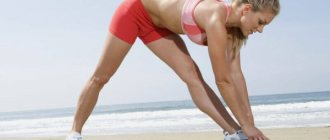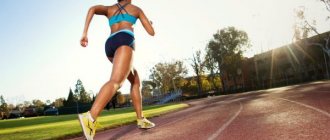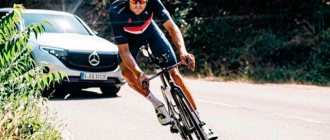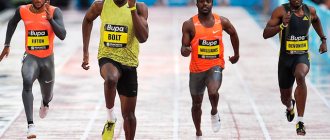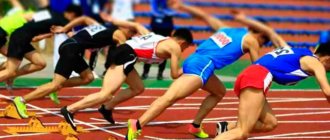Running with weights is an exercise for developing explosive strength, a powerful jerk in general, and athletic endurance as a related factor. The additional weight contributes to an unusual amount of muscle effort for the athlete, creating a stressful load on the muscles. Exercises with weights are used not only by runners and weightlifters: they are used at a certain stage of training by football players, volleyball players, basketball players, long jumpers, cyclists and representatives of other sports.
Why do you need to run with weights?
In 2002, scientists at Texas Tech University conducted a series of studies aimed at determining the effectiveness of weighting materials. The subject of the research was a local football team. For 6 weeks, the players performed traditional exercises to develop endurance and explosiveness. At the same time, part of the team used weight vests.
Having compared the results of both groups, scientists made a clear conclusion. The entire team improved their performance in the long and high jumps, as well as in the sprint run to 36.5 meters. However, the performance of the group that trained with weights increased significantly compared to the second group of players.
Increasing your own weight with weights makes you put more effort into running. As a result:
- Ligaments and tendons are strengthened
- Muscle mass increases
- Increases the force of the push when jumping
- Increases body endurance
- More calories burned
Research from the American Council on Exercise supports the use of lightweight weights. For example, running with 0.5-1 kg arm cuffs or 0.7-1.3 kg leg cuffs increases your heart rate by at least 10 beats per minute. At the same time, the level of oxygen consumption increases by 5-15%. This has a positive effect on the cardiovascular and respiratory systems.
General physical fitness exercises for runners in winter
For every serious running enthusiast, it is important to never stop improving yourself and training. Therefore, in the conditions of our country, it is necessary to somehow continue general physical fitness training during the winter months. An advantage of general training will be the opportunity to conduct a lesson even in the yard of your home.
Consider a list of specific exercises in winter:
- Squats . This universal activity can be done in any convenient place. The main condition is a stable surface underfoot. This makes the squat great for winter training.
- Lunges . An alternative to squats, do them while moving - this way you will develop more endurance. An excellent option for lunges is Bulgarian, which is performed alternately on each leg separately.
- Push ups . A high-intensity exercise that also does not require special conditions for execution. You can practice push-ups from behind.
- Pull-ups . A horizontal bar can be found in literally every yard. Pull-ups involve a large group: lats, biceps, back muscles. This will not only help with running, but will also help release a large amount of testosterone into the body.
- Hanging leg raise . If you find a bar, take care of the abdominal cavity. A great workout for your abs, quads and core muscles. Choose between straight legs and bent legs according to the load.
- Hanging oblique crunches . Variation of the previous exercise.
- Jumping on your toes . The complex perfectly develops the calf. Important for those who want to be less tired when running cross-country.
- Swing jumps . This is where the shoulders come into play. Good aerobic exercise.
- Stand on one leg or “pistol” . Another coordination exercise. If it is difficult to perform without support, do it next to a wall or leaning on something.
- High jump . Increases explosive muscle strength. Particularly suitable for short distance runners - sprinters. Variation - jumping with legs pulled to the chest.
Types of weights
Weights for running are divided into the following categories:
- Type – bulk and plate
- Weight – up to 1 kg, from 1 kg to 2.5 kg, over 2.5 kg
- Type – weights for arms, legs, vest, belt, backpack.
Plate weights
Plate weights are cuffs, belts or vests with pockets for metal plates. Their advantage is that the weight can be changed at will by adding or removing plates. Such weighting agents are stronger and more durable compared to bulk ones, however, their price is much higher.
Bulk weights
Bulk weights consist of dense fabric filled with sand or earth. They are cheaper than plate ones and are suitable for beginners as trial ones. However, their main drawback is that the weight cannot be adjusted. As some athletes note, such weights are short-lived, since the fabric begins to wear out and the sand spills out.
Hand weights come in the form of bracelets and dumbbells.
Hand bracelets
Bracelets are made of elastic or rubberized fabric. Cuffs made from thin knitwear are not durable. Their width is usually 10-15 cm, the length is adjustable with Velcro. The weight of such weights can vary from 0.5 to 5 kg.
Dumbbells
You can also use regular dumbbells or dumbbells with a special wrist mount as weights. The weight of the device should be comfortable for the runner.
Additional weight in the hands shifts the athlete's center of gravity, as a result of which the load is redistributed to other muscles. Running with dumbbells in your hands increases the load on the biceps, as well as the trapezius and deltoid muscles.
Bracelets and dumbbells increase the load on all muscle groups. But after training, the athlete usually feels more tired in the shoulder girdle, arms and upper back.
Running with a load on your arms will be useful for those who want to increase the load specifically on their arms, and also practice boxing or other martial arts. Runners with back or joint problems should limit themselves to jogging without weights.
Ankle weights
Leg weights differ from arm cuffs only in the length and width of the band. They fit over the ankle just above the shoe and fit securely on the foot. Be careful not to let the foot weight rub or slide on your ankle.
Running with weights on your legs works the soleus, gastrocnemius, and ankle muscles. Unlike a vest, leg cuffs reduce the load on the spine while working the columnar spinal muscles. This type of training also involves the rectus and oblique abdominal muscles.
Weight vest
It is worn on the upper body and resembles a bulletproof vest with many pockets for plates. The weight of the vest is adjusted depending on the type of training and the tasks that the athlete sets for himself. If you need to do endurance training, the optimal weight is 2.2 kg.
When starting to run with weights, it is better to start with equipment whose weight exceeds the athlete’s own weight by no more than 5%. By increasing the load gradually, you will avoid injuries to bones and tendons.
Belt - weighted
A belt is another type of weighting material, a lightweight version of a vest. The belt is securely fixed at the waist using a belt and does not hinder the athlete’s movements. Running with a belt allows you to pump up the muscles of your legs, abdomen, buttocks and lower back. Recommendations for choosing the optimal weight are the same as when choosing a vest.
Backpack as a weighting agent
Most often, a backpack is used as weighting material by marathon runners and other long-distance runners. The sports backpack is secured using adjustable chest and waist fastenings. Vests and backpacks for running have a high-quality ventilation and moisture removal system.
When choosing a backpack, pay attention to the position of the straps: they should fit the entire plane to the body, and not just one edge. The optimal weight of such a weighting material is 3 kg, that is, close to the weight of a backpack on the trail.
Is it possible to play sports?
Before answering this question, it is necessary to understand what exactly is meant by this term. If we are talking about therapeutic physical education (physical therapy), which is used as one of the methods of conservative treatment of intervertebral hernia, then there are practically no restrictions for exercise (with the exception of an acute period of illness, severe pain, inflammatory and infectious diseases in the spine).
Exercise therapy classes have a minimal number of contraindications and proven effectiveness
Exercise therapy is a set of exercises aimed at preventing a specific disease, as well as the recovery and rehabilitation of patients after suffering pathologies (including diseases with the use of surgical treatment methods).
Weight of weights
Weights up to 1 kg are usually used by athletes for dynamic training. This weight is also recommended for weight loss.
Weights with an average weight of 1 to 2.5 kg are used during long runs to train endurance. Can also be used by sprinters to increase their speed capabilities.
Weights greater than 2.5 kg are typically used for jogging, treadmill and machine exercises, and additional endurance exercises. Not recommended for beginners and people with insufficient physical fitness.
Exercises for the abs, back and arms: general recommendations
It is equally important for every runner to have strong and resilient legs and arms. This also applies to the rest of the muscles of the body: back, abs, shoulders. General physical training for these groups will become a new breath, a breakthrough to new victories. Since pumping these groups requires isolated exercises, you may need to use weights or additional equipment to achieve results. In this case, you don’t need to be shy about using bodybuilding elements. Here are some types of general physical training:
- Reverse grip pull-ups and pull-ups . The second option involves working the biceps to a greater extent.
- Bent-over load pull . In order to better feel your back, perform each hand alternately. One of the best exercises for the latissimus and rhomboid muscles on the back.
- Push ups . Push-ups work your upper body and arms well.
- Reverse push-ups . The exercise mainly targets the triceps. Any bench or chair will do. To add weight, place your feet on an elevated platform and place weights on your feet.
- Lifting weights on the biceps . Reference exercise for hands. Perform through full range of motion without using your shoulders for maximum effect. Arm work is especially important for stability when running.
- Mahi . It is better to perform this exercise with weights, for example, with a bottle of water. Pumps up the front and middle deltoids.
- Pressing a barbell or weight up . A basic complex for working out all deltas. Helps the runner better maintain balance and help with his hands.
- Plank and its various variations . Static isometric physical exercise for the abdominal and back muscles.
- Hanging leg raises . One of the most popular abdominal exercises.
- Hyperextension with round back . A universal exercise that strengthens the back muscles, back of the thigh and buttocks.
Running technique with weights
The use of weights of any kind changes running technique. A vest that is too heavy causes the athlete to take shorter, lower steps. The cuffs on the legs do not allow you to feel the flight phase inherent in natural running.
In order not to disrupt your running technique, start using weights no earlier than after six months of constant training. The use of weights by beginners gives them an initially incorrect running technique.
If you decide to diversify your running workout with weights, start with walking. Walking with dumbbells or cuffs on your legs will help you understand whether your body is ready to increase the load.
Shortness of breath, fatigue and rapid heartbeat indicate that it is too early to switch to training with increased complexity.
If the body easily adapted to the new load, start with hand weights with a total weight of 0.5 kg. After three weeks, you can increase the weight to 1 kg, over the next three weeks - up to 1.5 kg. Alternate weight training with rest days. Knee joints that are not accustomed to such loads are susceptible to injury.
Shuttle running at a heart rate of 50-70% of the maximum will help prepare your knees (for the average trained runner this is 120-130 beats per minute). When running with cuffs on your feet, make sure to use the correct technique: step on the surface with your heel, evenly distributing the load over the entire surface of the foot. Otherwise, there is a high probability of injury to the Achilles tendon. When running with a backpack or vest, watch your posture: your back should be clearly straight.
Safety precautions when running with weights
In the absence of direct contraindications, you can include running with weights in your weekly training program. To avoid possible problems with joints and muscles, follow simple tips.
Mandatory warm-up
Warming up before training with weights is of enormous importance. Perform gymnastic exercises to warm up the hip, neck and ankle joints. Include stretching exercises, squats, swings of arms and legs in your warm-up complex. Sprinting is the best preparation for maximum stress on the heart and nervous system.
Gradual increase in load and weight
Start by walking with a light backpack. Listen to how you feel while walking and the next day. If you usually run 10 km during training, then with additional weight you can run no more than 3-4 km. Increase the weight of the weights and the duration of the workout gradually.
Alternating load and rest
Running with weights five times a week can be dangerous. The best option is to alternate between heavy and light types of training. For example, run with added weight 1-2 times a week. On other days - interval and regular jogging, as well as endurance exercises.
Joint protection
Use warming ointment, knee pads and elastic bandages.
Suitable shoes
For extra heavy running, choose running shoes with thick soles and good cushioning in the heel.
Timely start
If you've never used weights for running, don't start experimenting the week before your marathon. Endurance will not have time to develop, but unprepared joints may be injured and will not have time to recover before the start of the competition.
Correct load distribution
Weights should not interfere with you while running. An off-balance backpack, a poorly secured belt, and hard chafing cuffs lead to injuries and impaired running technique.
Features of the disease
The main manifestation of a spinal hernia, regardless of its location, is pain.
Signs of a spinal hernia always manifest themselves in pain
The intensity of pain depends not only on the size of the hernial protrusion and the degree of compression (squeezing) of the nerve roots, but also on external factors, for example, nutrition. If the patient does not receive enough proteins (collagen), minerals (calcium, phosphorus, iron), vitamins, the nutrition of the cartilage plates is disrupted. They are located between two adjacent vertebrae, and the space between them is filled with gelatinous pulp - a viscous liquid containing a small number of cartilage cells. The pulp is surrounded by a fibrous membrane (annulus fibrosus), which holds the nucleus in the center of the intervertebral disc and prevents it from leaking into the spinal canal.
Spinal motion segment
When the nutrition of the cartilage is disrupted, it begins to “dry out,” which leads to deformation of the intervertebral disc. Over time, the spine contracts and the nucleus pulposus moves beyond the annulus fibrosus. The displaced pulp compresses the spinal roots, which causes acute pain and severely limits the patient’s mobility, and swelling and muscle spasm in the area of the affected segment of the spine allow partial compensation of the compressive load. If measures are not taken in time to correct the pathology, a complete rupture of the connective tissue membrane may occur and the pulp may escape into the space of the spinal canal.
Intervertebral hernia. Stages
For conservative treatment of pathology, medications (chondroprotectors, glucocorticosteroids, NSAIDs, vitamin complexes), traction therapy (spinal traction), and drug blockades using analgesics are used.
Note! Therapeutic and recreational physical education is an effective method for the prevention of intervertebral hernias and the treatment of small hernial protrusions without signs of compression of the spinal roots. In more severe cases, exercise therapy is used as an auxiliary method during a period of stable remission, provided it is combined with other treatment methods: massage, high-protein and fortified diet, alternative medicine techniques (manual therapy, hirudotherapy, etc.).
Benefits of running with weights
The benefits of training with weights depend on the type of activity and goals of the athlete:
- Increasing endurance when preparing for a marathon, doing extreme sports such as skyrunning and overcoming long distances in the mountains
- Increased leg strength (the so-called “explosive effect”) when running obstacles or hurdles, as well as long and high jumps
- Reducing the duration of your workout while maintaining its intensity
- Growth of bone cells as a result of increasing stress on the skeleton
- Strengthening the cardiovascular system (in the absence of chronic diseases)
- Accelerated burning of excess calories
- Uniform pumping of muscles throughout the body and improvement of muscle relief
Disadvantages of running with weights
The main disadvantage of such training is the inability of the leg muscles to relax during the flight phase. This makes the running technique forced and provokes wasteful expenditure of energy. Running with weights on your arms does not allow you to relax the muscles of your neck, arms and face, which is inherent in the natural running technique.
An incorrectly selected weight can lead to spinal injury. When running with weights, the impact force increases, which can lead to injuries to the knee joints. The heart, blood vessels and kidneys are also subject to additional stress. It is better to avoid running with weights if you have one or more of these health problems:
- Varicose veins of the legs
- High blood pressure
- Heart pathologies
- Urolithiasis disease
- Weak blood vessels
- Presence of cholesterol formations
- Rehabilitation period after injury
- Postoperative period
Will they help you gain muscle mass?
Increasing the intensity of training with the help of weights does not guarantee that muscle mass will also increase. “The weights used are very light in order to induce muscle growth. However, they make exercise more difficult and therefore help you burn more calories,” the expert notes.
Instagram content
This content can also be viewed on the site it originates from.
